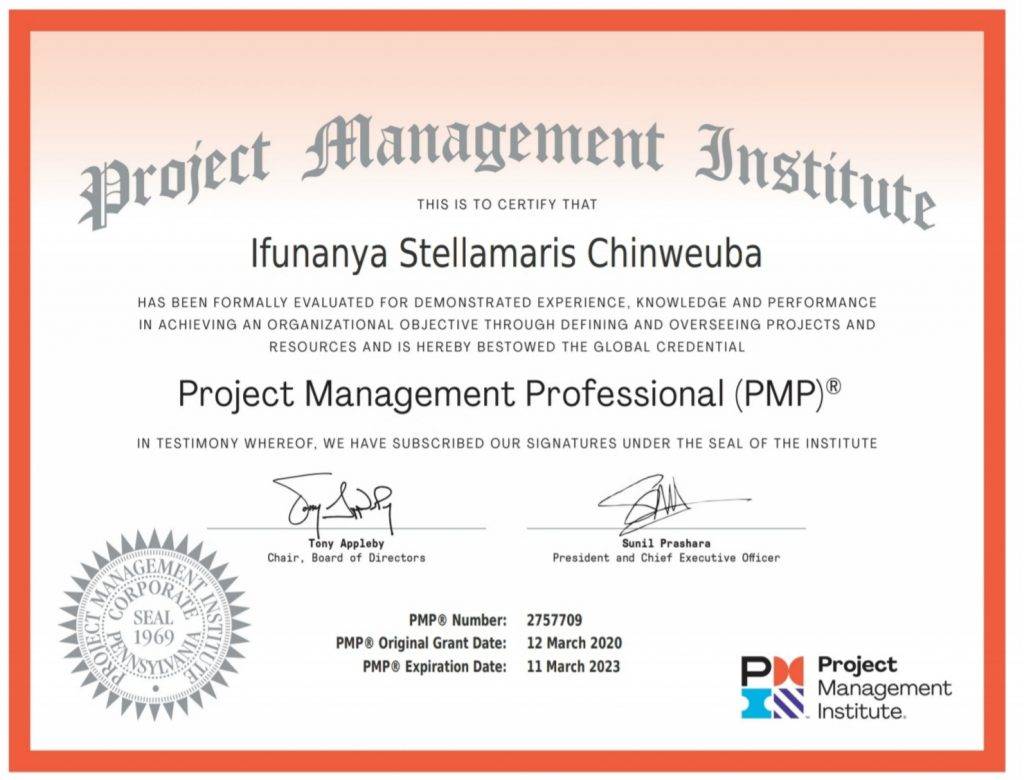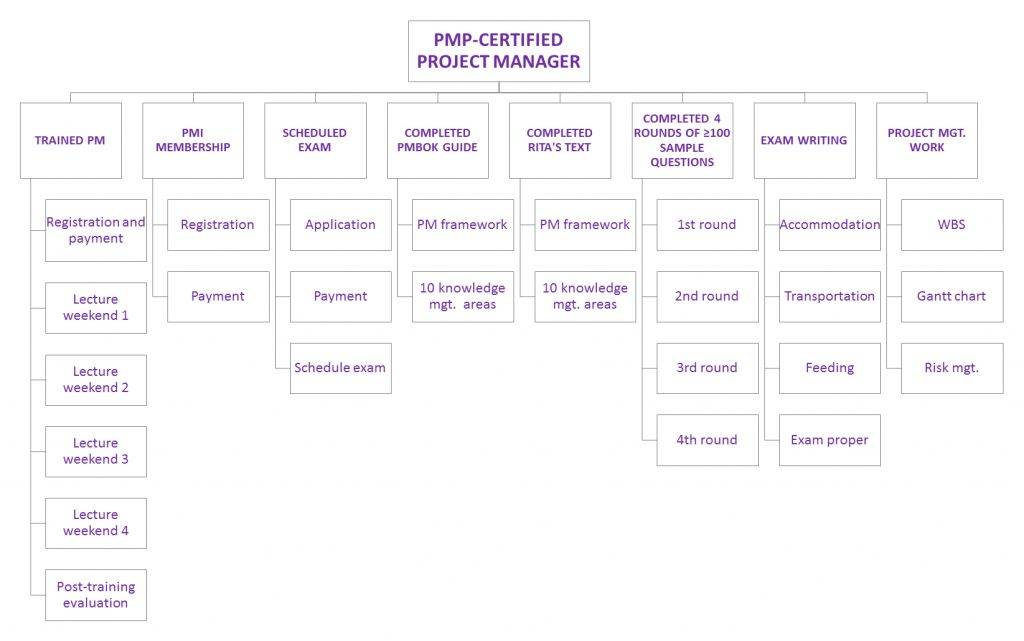
… well, no need for the long intro, I’m going to get straight to the point. Here are some of my tips for acing the exam at the first trial.
1. Managing the PMP certification goal as a project
I did that by decomposing the project’s scope into deliverables and their corresponding activities and then going ahead to monitor my progress at 2-week intervals. I also drew a work breakdown structure (WBS) and a Gantt chart for my goal. They helped me envision my workload and measure my progress. Like I’ll always advise, if you want to make reasonable progress in reaching your life goals, manage them as projects, it has many benefits. Here is a view of my WBS for my PMP certification goal:

You’ll also enjoy the privilege of planning the finance requirements of the project and not get frustrated as the project unfolds.
2. Shortening the time between training completion and writing the exam
It’s true different things work for people, but I think this suggestion is gold. My mentor suggests taking this exam at most 4 months after the training, I took mine within the 3rd month. In my opinion, the maximum should be 6 months. The essence is to sustain the same energy level up till the exam day.
3. Having a mentor and a study group
One of the benefits I enjoyed from my trainers was the post-training free mentorship I got until I wrote my exam. I trained with Dinak Strategy Consulting Limited and aside from their business of training us on the best practices of project management, I and my colleagues also enjoyed their free mentorship for an extra four months. I also had mentors from my industry whom I could easily reach out to whenever I get confused; find such mentors for yourself too, they’d come in handy.
4. Using enough but limited study material
One mistake people often make is to consume so many resources at the same time. Not only will this kill time, but it can also bring some confusion and anxiety. The best thing is to stick with basic materials that will give you access to an explanation of the domain areas alongside sample questions that you can practice with and review yourself. In my case, I used the following four materials:
- PMBOK Guide
- Rita Mulcahy’s Exam prep textbook
- PM Mentor
- PM Aspire
5. Reading smart
You’ll have an overwhelming task ahead, so it will be great if you outsmart the hill. Here are some of my tips:
- Memorise some things but try to understand them from the root.
- Get comfortable with answering situational questions.
- Jot down formulas in a notepad and practice through them within the last 24 hours before your exam.
- If you are using an exam prep like Rita Mulcahy’s, I will advise this. Before reading any chapter, answer its set of questions without scoring them and after reading it, re-answer the questions, then mark, compare your scores, and fill in your gaps.
- Some exam questions are wordy and when I meet them, here’s what I do. I read the last sentence to search for the actual question (it’s usually there) and then bearing the question in mind, I now go through the whole length of the question to search for the supporting information.
- Sometimes, when revising the “ITTOs”, study it in reverse order. For example, I imagine that I want to produce a project scope statement (output) and that I will need a Project charter, scope management plan, EEFs, OPAs, etc (inputs) to produce it via decision-making, expert judgement, etc (tools and techniques).
- When practising questions, get used to a noisy environment, you cannot tell what your D-day will be like.
6. Spending time to answer sample questions
Generally, when preparing for an exam, taking the team to look through its sample questions is always advisable. It gives you a picture of its questions’ pattern and you get the opportunity to practice the exam-time distribution before the main day. The exam is 200 MCQs written in 4 hours and that means that you have 1.2 minutes per question. The more questions you practice, the more familiar and confident you get with them. Doing this also has a way of restructuring your reading pattern. You begin to appreciate what to focus on and what to know on a high level. You will also successfully frame how questions from different topics can be presented and make your reading effort more fruitful. In this project, time is a major constraint. You will never have enough time to finish preparing for your exam, so try to make the most out of the time you already have.
In summary
Equipping your portfolio with a PMP certification is a worthy achievement. If you have made up your mind to pursue this goal, then try and commit the necessary time, effort, and resources to it. Manage the goal as a project and stay focused and committed.
Good luck.







